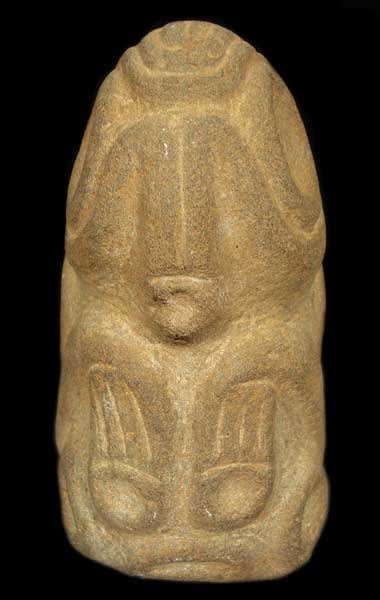Taino Stone Zoomorphic Sculpture, 1000 CE - 1500 CE
Stone
11 x 9.1
AM.0084
This is an incredibly rare and unusual example of Taino stone carving. It depicts a creature in a crouching position with its legs folded under the body. The large circular...
This is an incredibly rare and unusual example of Taino stone carving. It depicts a creature in a crouching position with its legs folded under the body. The large circular eyes dominate the face, set either side of an elongated snout/nose. Beneath this are two paws or legs, briefly indicated with long straight incisions and two oval indentations. The other elements of the body are difficult to read; for example, the intricately incised panels on the sides could be wings or limbs. An interest in complex geometrical forms is a recurring feature in Taino art and this piece is no exception. The labyrinth-style designs may reflect high quality textiles or tattoos worn by the Taino elite. In any case they are likely to have had a cosmological significance that is difficult to reconstruct today.
The Taino flourished in the islands of the Caribbean c.1200-1500. They had a highly developed belief system that focused on the worship of zemis. A zemi was the physical manifestation of a god, spirit or ancestor. The chieftains (caciques) encouraged ancestor worship and were often deified after death. The religious leaders or shamans were believed to be able to communicate with the souls of the dead when intoxicated by the hallucinogenic cohoba. A preoccupation with death is evident in many Taino art-forms and partly explains the prevalence of zoomorphic images. Bats, owls and frogs were all popular motifs and were regarded as harbingers of death. Even more relevant in this case was the belief that the dead could be reborn in animal form. Animals were also regarded as the earliest ancestors in Taino creation myths. A sculpture of this size and complexity undoubtedly belonged to one of the chieftains or a member of his retinue and must have had an important function in religious ritual.
The Taino flourished in the islands of the Caribbean c.1200-1500. They had a highly developed belief system that focused on the worship of zemis. A zemi was the physical manifestation of a god, spirit or ancestor. The chieftains (caciques) encouraged ancestor worship and were often deified after death. The religious leaders or shamans were believed to be able to communicate with the souls of the dead when intoxicated by the hallucinogenic cohoba. A preoccupation with death is evident in many Taino art-forms and partly explains the prevalence of zoomorphic images. Bats, owls and frogs were all popular motifs and were regarded as harbingers of death. Even more relevant in this case was the belief that the dead could be reborn in animal form. Animals were also regarded as the earliest ancestors in Taino creation myths. A sculpture of this size and complexity undoubtedly belonged to one of the chieftains or a member of his retinue and must have had an important function in religious ritual.



